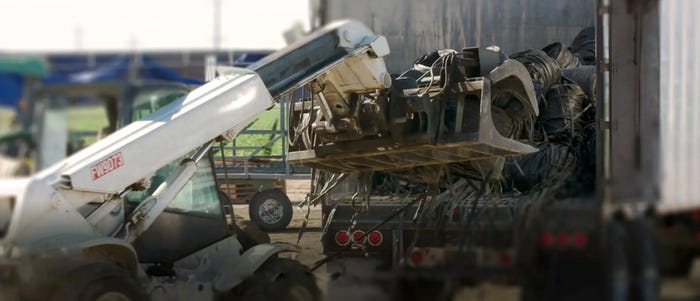Netafim Targets Plastic Farm Waste
Driplines come with tradeoffs. They are made of a thin polyethylene (PE) and last for only one crop rotation, leaving a heaping pile of trash at the end of each season.

Land and water resources are shrinking across the globe while the population is growing, leaving farmers who feed the world with a formidable task: figuring out how to produce more food with less, and to do it sustainably as the earth they promise to protect warms. Some evolving agricultural technologies help, with one being drip irrigation systems that use the least amount of water to grow the most crops on a given plot of ground.
Driplines distribute water at the root source, just above the ground, reportedly saving up to 70% of this precious resource, compared to overhead sprinklers where substantial water evaporates before it hits the ground. But driplines come with tradeoffs. They are made of a thin polyethylene (PE) and last for only one crop rotation, leaving a heaping pile of trash at the end of each season.
With that thought, Netafim USA, makers of drip irrigation technology, figured out a way to recycle the material, creating a continuous loop where farmers can maximize resources; they dispose of the material once it’s spent then have it come back to them as new dripline.
“We can use the same tape again and again without compromising performance. It lasts as long. And because we buy much less resin on the open market it saves growers money,” says Tate Kelley, product manager, Netafim USA.
Some virgin resin is added to maintain strength as well as carbon black, which acts as a UV radiant to guard against direct sun.
One grower typically buys about 10 truckloads of dripline a season, which is about 310,000 pounds of material. Netafim alone deals with 40-some growers on California’s central coast. Imagine the volume of would-be plastic trash.

“We help with the hassle of removing the tape from the field as soon as they are done with their crop rotations. It would otherwise go to landfill, and we did not want it on our record that Netafim is selling driplines that are ending up in landfills,” Kelley says.
Agriculture equipment manufacturer Andros is paid by the pound to pick up the material and deliver it to Netafim’s recycling plant in Fowler, California near Fresno where it’s shredded, washed, and pelletized.
There are rocks, dirt, plastic, and other contaminants that have to be removed from the massive coils fed into the shredder. This is where the process gets hard, Kelley says.
“We ask growers not to have garbage in the material, but there will inevitably be dirt. It’s wet, and it’s heavy.”
The binder, a mechanism that Andros makes, forms the lines in a tight coil, making it easy to pick them up in huge volumes, load, and store them.
Netafim’s recycling facility is certified by SCS Global Services, as are the resin pellets, confirming their recycled PE content. An independent, third-party audit checks for manufacturing data, chain of custody procedures, material qualifications, and mass-balance calculations.
“[SCS’s] Recycled Content Standard was introduced in 1989, a response to the burgeoning interest in recycled content claims and the introduction of innovative new recycling technologies. More than three decades later, the demand for recycled products and materials continues to grow, and SCS has certified thousands of products worldwide,” says Nicole Munoz, SCS Global Services vice president of Environmental Certification Services.
Certification is proving of value to growers.
“Big ag has a bad rap, and [small- to moderate-sized] family-owned operations get looped in. We are helping farmers on the California Coast prove to their customers –the Costco’s, Walmart’s, and Trader Joe’s—that they are growing the best crop possible, as sustainably as possible,” Kelley says.
When Braga Fresh switched to a drip tape irrigation system, it was important to use it for as long as possible to minimize cost and on-farm waste. But the team quickly realized the labor cost to continually repair the plastic tape was exorbitant.
“When Netafim started its closed-loop recycling system, it was a no brainer for us. We bundle it after use, and they do the rest. It gives us peace of mind knowing the plastic will be repurposed instead of ending up in a landfill,” says Katie Chiapuzio, director of Environmental Science and Resources, Braga Fresh.
Chiapuzio anticipates as consumers learn more about practices along the whole supply chain, investing in more sustainable material will help with brand loyalty.
“Buyers constantly ask about the recyclability of our product packaging. It’s only a matter of time before they start looking at farm-level recycling,” she says.
Some consumers are already asking about agricultural practices. Their curiosity combined with the industry’s expansive footprint will likely propel Netafim’s growth, especially given its location, Kelley speculates. In 2022 California was home to about 240,000,000 operating farms, according to the U.S. Department of Agriculture.
The company recently launched another recycling plant in Kukulkan, Mexico. Now it’s looking to expand recovery efforts to Texas, and to roll out in other key U.S. markets in the future.
Kelley sees the operation he works for as growers’ partners in the quest to further “green” agriculture.
“Farmers don’t just leave the soil as it is after a crop rotation. They get it ready for the next one. We also need to do our part to be ready for the next season. So, our job is not done once we put driplines in the field. We have a role to play in sustainability too,” he says.
